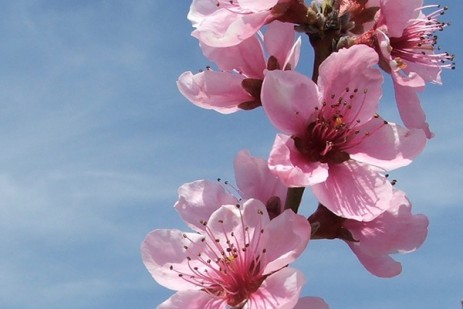Our studies show that any bud loss is compensated by a reduced natural drop. If you are considering blossom thinning, start by setting up a trial in one of your peach blocks. There is a small window of opportunity for thinning peach trees at bloom, but labor savings and increases in fruit size can be substantial.

This tractor-mounted string blossom thinner was designed for peach trees based on field trial experiences in Pennsylvania. The height and angle of the spindle are adjustable to conform to the height and form of the tree canopy. The intensity of thinning is adjustable by changing the rotation speed or the tractor speed. Photo: Mark Wherley
Growers who already have a tractor-mounted string blossom thinner are sometimes willing to cost-share with a neighbor. On a smaller scale, try rubbing off blossoms from the sides and undersides of branches by hand or with the aid of a brush. With practice, hand removal may take only five minutes on a detail-pruned tree. Hand-held string blossom thinners are also commercially available.
Peach orchards are typically hand-thinned at around 30 to 40 days after bloom, but this practice is labor-intensive and costly. While apples can be chemically thinned to reduce labor requirements, there are no effective fruit thinners for peaches. We have tested candidates for chemically thinning peaches at bloom, but none have been registered, and our research shows mechanical thinning of blossoms is more predictable. Another benefit is that you can immediately see the results and easily adjust the level of thinning. For example, with varieties that are difficult to size, you can remove a larger portion of the blossoms by increasing the spindle rotation speed or the tractor speed. Open blossoms are easier to remove than closed blossoms, so thinning when around 80% of the blossoms are open also increases response to mechanical thinning.

Peach fruiting shoots before, right, and after, left, mechanical blossom thinning at 80% full bloom. Photos: Tara Baugher, Penn State
Aim to remove about one-half of the blossoms. Even when a small number of blossoms have been removed, there will likely be a lot of flower petals on the ground, so be sure to “calibrate” thinning based on tree observations. Start by tagging two branches on five or six trees, and assess mechanical thinner performance on these trees before thinning an entire block. Count the blossoms on those limbs before and after thinning to get a feel for various levels of crop load adjustment. Jim Schupp reports he string thins his peaches at the Penn State Fruit Research and Extension Center most years, even during seasons with an early bloom, and he has become increasingly comfortable with more aggressive levels of thinning. It’s important to avoid over-thinning, however. A good gauge is to calculate how many fruit a block should bear per acre and work backward to how many per tree and how many per fruiting shoot. Then leave twice as many as flowers per fruiting shoot.
Although it will be tempting to thin the entire block, be sure to leave some untreated trees. You can then compare differences in follow-up hand-thinning labor requirements at the green fruit stage. The thinning time has been reduced in our research trials by as much as 50 percent. Most of our commercial-scale studies also showed an increase in the percentage of fruit in larger fruit size categories that have the highest market value, so take time to make these comparisons at harvest. Grower observations indicate another benefit is an improvement in the seasonal distribution of labor-intensive work. Net economic impact in uniform, multi-year trials conducted across four major peach producing regions was $250 to $850 per acre. For more information on Penn State research on peach blossom thinning, visit Orchard Automation – Crop Load Management.

Fruit size comparisons of White Lady peach at harvest. Peaches on the left were hand-thinned. Peaches on the right were blossom-thinned with a string thinner. Photos: Tara Baugher, Penn State
Penn State and Carnegie Mellon, graduate engineering students, collaborated on research to automate the positioning of the mechanical blossom thinner. This innovation reduced driver fatigue and increased precision.















